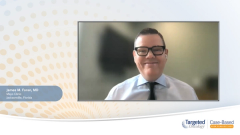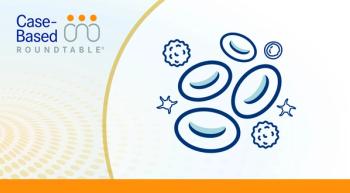
Understanding How BPDCN Manifests in Clinical Practice
A key opinion leader identifies the clinical manifestations and diagnostic markers of blastic plasmacytoid dendritic cell neoplasm, shedding light on its presentation and diagnostic significance in real-world medical settings.
Episodes in this series

Transcript:
James M. Foran, MD: This is apparent in this case that we presented, but how does a BPDCN [blastic plasmacytoid dendritic cell neoplasm] manifest? It can present as an acute leukemia, a classical acute leukemia, but a...significant number of patients will have lymphadenopathy, cutaneous involvement, and can have occult [central nervous system] or [cerebrospinal fluid] involvement. In this case, a patient who comes in with just a few months of fatigue and weight loss, and then 3 weeks as our 87-year-old patient with these cutaneous nodules, I would actually call them masses, more commonly. That is a presentation where you would suspect a BPDCN with these purpuric nodules, sometimes with black eschar associated with them. Often it’s a short history. So, a patient who’s had a very long history would be uncommon. This is usually a relatively short history manifesting as a BPDCN. The patient in this case, an 87-year-old, is a little older, but [the case] reflects the fact that this does happen in 70-year-olds and older patients.
It can happen in younger patients. We’ve certainly seen that in our practice at Mayo Clinic across our 3 cancer center sites. We mentioned already that CD123 is integral in testing and diagnosing this. We have added that to our immunohistochemistry panel and our flow cytometry panels. It was recognized that CD123, the IL3 receptor, was expressed in this situation. It’s also expressed, overexpressed in some other acute leukemias. It was really the insight of investigators who found that you could use diphtheria toxins in old literature, and then coming up with a fusion protein that’s tagraxofusp, which is now FDA approved, which is a CD123-targeted, truncated version of the diphtheria toxin, and really was instrumental in highlighting the presence of the disease, recognizing the frequency of the disease, and showing us a path forward in targeting CD123.
It’s now routine in our panels at Mayo Clinic, and I think that’s become common at academic centers across the country, and the large reference labs as well.… Tagraxofusp is the only FDA-approved treatment for CD123, but there are other strategies being evaluated like antibody-based [therapy] or CAR T-cell [therapy], or bispecific targeting of CD123 based on these observations. I think it highlights the importance of this marker and how that’s driving other research in the field.
Other notable markers in BPDCN, in addition to CD123, are CD4 and CD56. Some other immunohistochemical stains, like TCL1 also. And even though there’s not a unique or specific pattern of cytogenetics or of gene mutation, it’s important to get karyotype on these patients. It will help guide prognosis and transplant decisions. And it’s also important to do the sequencing. It’s not common to have targetable markers based on current agents, but we are hoping in the future that we’ll be able to target the RAS pathway, TP53 pathway, ASXL1, and other pathways. It matters for prognosis and that we should be evaluating these markers as we do in other acute leukemias.
When you think about the current available treatment options for a patient with a newly diagnosed BPDCN and what factors into the decision-making, I would refer you to the [National Comprehensive Cancer Network] guidelines. This is now included on our guideline panel that we’ve discussed. Tagraxofusp has a first-line indication from the FDA for BPDCN. Historically, these patients were treated with acute leukemia regimens. There’s literature for [acute myeloid leukemia] regimens with 7+3, and there’s possibly more robust literature for [acute lymphoblastic leukemia] regimens and particularly the hyper-CVAD [hyperfractionated cyclophosphamide, vincristine, doxorubicin, and dexamethasone] regimen pioneered at MD Anderson [Cancer Center] in Houston, [Texas].
You can get meaningful remissions with acute leukemia induction therapy. We see patients come in diagnosed [with] acute leukemia, receive hyper-CVAD or a 7+3 regimen, and come for a transplant consult; we review their pathology and find they had a BPDCN. You can get meaningful remissions. However, the duration of remission is shorter in those situations or appears to be shorter. In that situation for younger, transplant-eligible patients for whom we can find a suitable donor, which we frequently can for patients under age 75, we would consider consolidation with allogeneic transplant.
Tagraxofusp is FDA approved as a first-line agent, and that was based on a pivotal trial published in the New England Journal of Medicine and then follow-up in the Journal of Clinical Oncology by Naveen Pemmaraju, [MD, at the University of Texas MD Anderson Cancer Center in Houston]; Andrew Lane, [MD, at the Dana-Farber Cancer Institute in Boston, Massachusetts]; and others. This is a rare disease, and it took a national community and sponsored clinical trials to identify these patients and evaluate this treatment.
But tagraxofusp is given on a regular basis initiated typically in the hospital if there’s active acute leukemia for monitoring and has some particular adverse effects. I’ll talk about that in just a few minutes, but these have to be monitored, capillary leak syndrome and elevated [leukotriene E4 levels] being the big ones. But it tends to be quite well tolerated, has responses, and the responses usually happen within the first 5 or 6 weeks. This is a medicine that can be continued in these patients. Because of the response rates and the relative safety and tolerance of this compared with an acute leukemia regimen, it is a very appropriate first-line treatment for this 87-year-old patient who’s come in with systemic involvement, with leukemic involvement in the blood and bone marrow from the BPDCN and the cutaneous involvement with his performance status.
That really makes it a very attractive first-line agent for this patient. I’ll highlight that tagraxofusp should be started in the hospital because of the specific monitoring it requires and can then be continued safely as an outpatient. It requires hands-on decision-making and trained staff because of its unique toxicities.
Transcript is AI-generated and edited for readability.










































